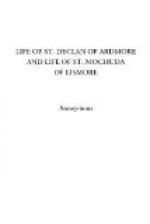Three different Lives of Mochuda are known to the present writer. Two of them are contained in a Ms. at Brussels (C/r. Bindon, p. 8, 13) and of one of these there is a copy in a Ms. of Dineen’s in the Royal Irish Academy (Stowe Collection, A. IV, I.) Dineen appears to have been a Cork or Kerry man and to have worked under the patronage of the rather noted Franciscan Father Francis Matthew (O’Mahony), who was put to death at Cork by Inchiquin in 1644. The bald text of Dineen’s “Life” was published a few years since, without translation, in the ‘Irish Rosary.’ The corresponding Brussels copy is in Michael O’Clery’s familiar hand. In it occurs the strange pagan-flavoured story of the British Monk Constantine. O’Clery’s copy was made in January, 1627, at the Friary of Drouish from the Book of Tadhg O’Ceanan and it is immediately followed by a tract entitled—“Do Macaib Ua Suanac.” The bell of Mochuda, by the way, which the saint rang against Blathmac, was called the ‘glassan’ of Hui Suanaig in later times.
The “Life” here printed, which follows the Latin Life so closely that one seems a late translation of the other, is as far as the editor is aware, contained in a single Ms. only. This is M. 23, 50, R.I.A., in the handwriting of John Murphy, “na Raheenach.” Murphy was a Co. Cork schoolmaster, scribe, and poet, of whom a biographical sketch will be found prefixed by Mr. R. A. Foley to a collection of Murphy’s poems that he has edited. The sobriquet, “na Raheenach,” is really a kind of tribal designation. The “Life” is very full but is in its present form a comparatively late production; it was transcribed by Murphy between 1740 and 1750. It is much to be regretted that the scribe tells us nothing of his original. Murphy, but the way, seems to have specialised to some extent in saint’s Lives and to have imbued his disciples with something of the same taste. One of his pupils was Maurice O’Connor, a scribe and shipwright of Cove, to whom we owe the Life of St. Ciaran of Saighir printed in “Silva Gadelica.” The reasons of choice for publication here of the present Life are avowedly non-philological; the motive for preference is that it is the longest of the three Lives and for historical purposes the most important.




